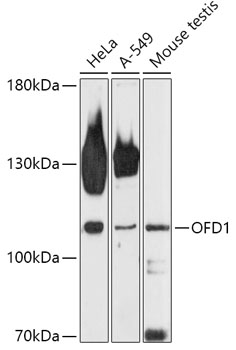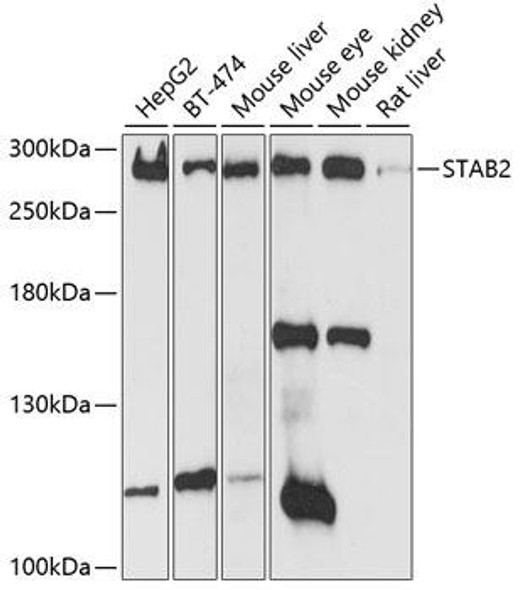Anti-OFD1 Antibody (CAB17567)
- SKU:
- CAB17567
- Product type:
- Antibody
- Reactivity:
- Human
- Mouse
- Host Species:
- Rabbit
- Isotype:
- IgG
- Antibody Type:
- Polyclonal Antibody
Frequently bought together:
Description
| Antibody Name: | Anti-OFD1 Antibody |
| Antibody SKU: | CAB17567 |
| Antibody Size: | 20uL, 50uL, 100uL |
| Application: | WB |
| Reactivity: | Human, Mouse |
| Host Species: | Rabbit |
| Immunogen: | Recombinant fusion protein containing a sequence corresponding to amino acids 763-1012 of human OFD1 (NP_003602.1). |
| Application: | WB |
| Recommended Dilution: | WB 1:500 - 1:2000 |
| Reactivity: | Human, Mouse |
| Positive Samples: | HeLa, A-549, Mouse testis |
| Immunogen: | Recombinant fusion protein containing a sequence corresponding to amino acids 763-1012 of human OFD1 (NP_003602.1). |
| Purification Method: | Affinity purification |
| Storage Buffer: | Store at -20°C. Avoid freeze / thaw cycles. Buffer: PBS with 0.02% sodium azide, 50% glycerol, pH7.3. |
| Isotype: | IgG |
| Sequence: | PSPC PDRM PLPS PTES RHSL SIPP VSSP PEQK VGLY RRQT ELQD KSEF SDVD KLAF KDNE EFES SFES AGNM PRQL EMGG LSPA GDMS HVDA AAAA VPLS YQHP SVDQ KQIE EQKE EEKI REQQ VKER RQRE ERRQ SNLQ EVLE RERR ELEK LYQE RKMI EESL KIKI KKEL EMEN ELEM SNQE IKDK SAHS ENPL EKYM KIIQ QEQD QESA DKSS KKMV QEGS LVDT LQSS DKVE SLTG FSHE ELDD SW |
| Gene ID: | 8481 |
| Uniprot: | O75665 |
| Cellular Location: | |
| Calculated MW: | 42kDa/111kDa/116kDa |
| Observed MW: | 117kDa |
| Synonyms: | 71-7A, CXorf5, JBTS10, RP23, SGBS2, OFD1 |
| Background: | This gene is located on the X chromosome and encodes a centrosomal protein. A knockout mouse model has been used to study the effect of mutations in this gene. The mouse gene is also located on the X chromosome, however, unlike the human gene it is not subject to X inactivation. Mutations in this gene are associated with oral-facial-digital syndrome type I and Simpson-Golabi-Behmel syndrome type 2. Many pseudogenes have been identified; a single pseudogene is found on chromosome 5 while as many as fifteen have been found on the Y chromosome. [provided by RefSeq, Aug 2016] |
| UniProt Protein Function: | OFD1: Component of the centrioles controlling mother and daughter centrioles length. Recruits to the centriole IFT88 and centriole distal appendage-specific proteins including CEP164. Involved in the biogenesis of the cilium, a centriole-associated function. The cilium is a cell surface projection found in many vertebrate cells required to transduce signals important for development and tissue homeostasis. Plays an important role in development by regulating Wnt signaling and the specification of the left-right axis. Defects in OFD1 are the cause of oral-facial-digital syndrome type 1 (OFD1). OFD1 is a X-linked dominant condition with lethality in males. The syndrome is characterized by clefts of the jaw and tongue in the area of the lateral incisors and canines. Other features are malformations of the face and skull, malformation of the hands (specifically syndactyly, clinodactyly, brachydactyly and occasionally postaxial polydactyly) and mental retardation. OFD1 also causes polycystic kidney disease. Defects in OFD1 are associated with Simpson-Golabi-Behmel syndrome type 2 (SGBS2). SGBS2 is a severe variant of Simpson-Golabi-Behmel syndrome, a condition characterized by pre- and postnatal overgrowth (gigantism), facial dysmorphism and a variety of inconstant visceral and skeletal malformations. Defects in OFD1 are the cause of Joubert syndrome type 10 (JBTS10). A disorder presenting with cerebellar ataxia, oculomotor apraxia, hypotonia, neonatal breathing abnormalities and psychomotor delay. Neuroradiologically, it is characterized by cerebellar vermian hypoplasia/aplasia, thickened and reoriented superior cerebellar peduncles, and an abnormally large interpeduncular fossa, giving the appearance of a molar tooth on transaxial slices (molar tooth sign). Additional variable features include retinal dystrophy and renal disease. Belongs to the OFD1 family. 3 isoforms of the human protein are produced by alternative splicing. |
| UniProt Protein Details: | Protein type:Cell cycle regulation Chromosomal Location of Human Ortholog: Xp22 Cellular Component: centriole; centrosome; cilium; cytosol; membrane; microtubule cytoskeleton Molecular Function:alpha-tubulin binding; gamma-tubulin binding; identical protein binding; protein binding Biological Process: centriole replication; G2/M transition of mitotic cell cycle; mitosis Disease: Joubert Syndrome 10; Orofaciodigital Syndrome I; Retinitis Pigmentosa 23; Simpson-golabi-behmel Syndrome, Type 2 |
| NCBI Summary: | This gene is located on the X chromosome and encodes a centrosomal protein. A knockout mouse model has been used to study the effect of mutations in this gene. The mouse gene is also located on the X chromosome, however, unlike the human gene it is not subject to X inactivation. Mutations in this gene are associated with oral-facial-digital syndrome type I and Simpson-Golabi-Behmel syndrome type 2. Many pseudogenes have been identified; a single pseudogene is found on chromosome 5 while as many as fifteen have been found on the Y chromosome. [provided by RefSeq, Aug 2016] |
| UniProt Code: | O75665 |
| NCBI GenInfo Identifier: | 1055970449 |
| NCBI Gene ID: | 8481 |
| NCBI Accession: | NP_001317138.1 |
| UniProt Secondary Accession: | O75665,O75666, Q4VAK4, B9ZVU5, |
| UniProt Related Accession: | O75665 |
| Molecular Weight: | |
| NCBI Full Name: | oral-facial-digital syndrome 1 protein isoform 2 |
| NCBI Synonym Full Names: | OFD1, centriole and centriolar satellite protein |
| NCBI Official Symbol: | OFD1 |
| NCBI Official Synonym Symbols: | RP23; 71-7A; SGBS2; CXorf5; JBTS10 |
| NCBI Protein Information: | oral-facial-digital syndrome 1 protein |
| UniProt Protein Name: | Oral-facial-digital syndrome 1 protein |
| UniProt Synonym Protein Names: | Protein 71-7A |
| Protein Family: | Oral-facial-digital syndrome 1 protein |
| UniProt Gene Name: | OFD1 |
| UniProt Entry Name: | OFD1_HUMAN |








